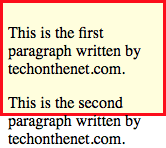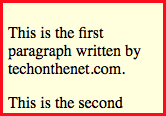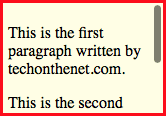
CSS: overflow-y property
This CSS tutorial explains how to use the CSS property called overflow-y with syntax and examples.
Description
The CSS overflow-y property defines what to do when content overflows the content box vertically (ie: top and bottom), such as displaying the content outside of the content box, clipping the content, or displaying a vertical scroll bar.
Syntax
The syntax for the overflow-y CSS property is:
overflow-y: value;Parameters or Arguments
- value
The behavior to apply when content overflows the content box vertically. It can be one of the following:
Value Description visible Content is not clipped, but is displayed outside of the content box (this is the default behavior)
div { overflow-y: visible; }hidden Content is clipped, the overflow content is hidden, and no vertical scroll bar is displayed
div { overflow-y: hidden; }scroll Content is clipped and the vertical scroll bar is displayed
div { overflow-y: scroll; }auto Browser determines what to do with the overflow content, which can vary from browser to browser (but generally results in the vertical scroll bar being displayed as required)
div { overflow-y: auto; }inherit Element will inherit the overflow from its parent element
div { overflow-y: inherit; }
Note
- The overflow-y property applies to block, inline-block and table cells.
- The overflow-y property does not handle horizontal overflow. To handle horizontal overflow, see the overflow and overflow-x properties.
Browser Compatibility
The CSS overflow-y property has basic support with the following browsers:
- Chrome
- Firefox (Gecko)
- Internet Explorer (IE)
- Opera 9.5+
- Safari (WebKit)
Example
We will discuss the overflow-y property below, exploring examples of how to use this property in CSS.
Visible
Let's look at an example where we set the overflow-y to visible.
The CSS would look like this:
div { background: lightyellow; border: 3px solid red; padding: 5px; height: 100px; width: 150px; overflow-y: visible; }The HTML would look like this:
<div>
<p>This is the first paragraph written by techonthenet.com.</p>
<p>This is the second paragraph written by techonthenet.com.</p>
</div>The result would look like this:

In this CSS overflow-y example, we have set the overflow-y to visible which means that when the content overflows the content box vertically (ie: top to bottom), it is not clipped but will display outside of the content box.
Hidden
Now, let's take our same example and set the overflow-y to hidden.
The CSS would look like this:
div { background: lightyellow; border: 3px solid red; padding: 5px; height: 100px; width: 150px; overflow-y: hidden; }The HTML would look like this:
<div>
<p>This is the first paragraph written by techonthenet.com.</p>
<p>This is the second paragraph written by techonthenet.com.</p>
</div>The result would look like this:

In this CSS overflow-y example, we have set the overflow-y property to hidden so when the content overflows the content box vertically (ie: top to bottom), it is hidden and no scroll bars are displayed.
Scroll
Finally, let's take our example and set the overflow-y to scroll to see what happens.
The CSS would look like this:
div { background: lightyellow; border: 3px solid red; padding: 5px; height: 100px; width: 150px; overflow-y: scroll; }The HTML would look like this:
<div>
<p>This is the first paragraph written by techonthenet.com.</p>
<p>This is the second paragraph written by techonthenet.com.</p>
</div>The result would look like this:

In this CSS overflow-y example, we have set the overflow-y property to scroll so when the content overflows the content box vertically (ie: top to bottom), it is clipped and the vertical scroll bar is displayed.
Advertisements





